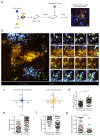Bystander IFN-γ activity promotes widespread and sustained cytokine signaling altering the tumor microenvironment
- PMID: 32803171
- PMCID: PMC7115926
- DOI: 10.1038/s43018-020-0038-2
Bystander IFN-γ activity promotes widespread and sustained cytokine signaling altering the tumor microenvironment
Abstract
The cytokine IFN-γ produced by tumor-reactive T cells is a key effector molecule with pleiotropic effects during anti-tumor immune responses. While IFN-γ production is targeted at the immunological synapse, its spatiotemporal activity within the tumor remains elusive. Here, we report that while IFN-γ secretion requires local antigen recognition, IFN-γ diffuses extensively to alter the tumor microenvironment in distant areas. Using intravital imaging and a reporter for STAT1 translocation, we provide evidence that T cells mediate sustained IFN-γ signaling in remote tumor cells. Furthermore, tumor phenotypic alterations required several hours of exposure to IFN-γ, a feature that disfavored local IFN-γ activity over diffusion and bystander activity. Finally, single-cell RNA-seq data from melanoma patients also suggested bystander IFN-γ activity in human tumors. Thus, tumor-reactive T cells act collectively to create large cytokine fields that profoundly modify the tumor microenvironment.
Conflict of interest statement
Competing interests statement The authors declare no competing interests.
Figures
















Comment in
-
Carpet-bombing tumors with IFN-γ.Nat Cancer. 2020 Mar;1(3):270-272. doi: 10.1038/s43018-020-0042-6. Nat Cancer. 2020. PMID: 35122031 No abstract available.
References
Publication types
MeSH terms
Substances
Grants and funding
LinkOut - more resources
Full Text Sources
Molecular Biology Databases
Research Materials
Miscellaneous

